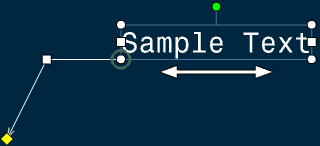About Annotations | ||||
|
| |||
Definition of Text Properties
Text properties can be applied to text, dimension text, text with leader, balloon and datum target, as well as to text included in datum features and geometrical tolerances. You can set the properties of an annotation text (such as font style, size and justification) either before or after creating this annotation.
To set text properties, simply select the text and choose the properties you want to apply to this text in the Text Properties toolbar. For more information, refer to About the Text Properties Toolbar.
| Important: In case of a dimension, the symbol inserted from the Text Properties toolbar is a prefix. You cannot have both a prefix and a suffix on a dimension. If a suffix is displayed on a dimension, creating a prefix with the Text Properties toolbar deletes it from the view, and the prefix only is displayed. |
![]()
DS ISO 1 Open Type Font
When selecting a font style in the Text Properties toolbar, one of the available choices will be DS ISO 1.
DS ISO 1, an Open Type font based on the ISO 3098 standard defining text representation, is delivered along with the application to ease the exchange of standardized documents.
| Important: DS ISO 1 is provided "as is". It is left up to each user/company to decide whether this font fits requirements in terms of annotation representation and compliance to ISO standards (or any other standard). |
From a general standpoint, DS ISO 1 is a variable-pitch font, designed as Open Type with True Type format outlines definition. It has been designed based on ISO 3098-5:1997, ISO 3098-3:2000 and Unicode definition (i.e. character codes are assigned in accordance with Unicode definition). In particular, characters' shape, box and dimensions are based on ISO 3098-5:1997, ISO 3098-3:2000 with lettering type CB vertical (regular) and slopped (italic).
The bold style is not defined in ISO3098. A thickness has been defined for the Bold and Bold Italic styles, consisting in a 50% addition to that of the regular style.
DS ISO 1 contains glyphs covering the following Unicode ranges:
- Controls and Basic Latin
- Controls and Latin 1 Supplement
- Latin Extended A
- Greek
- Cyrillic
- Enclosed Alphanumeric
Four new standards (ISO_DS, ISO_3D_DS, JIS_DS, JIS_3D_DS) are available that use DS ISO 1 as the default font. For more information, refer to Interactive Drafting User's Guide: Administration: About Standards.
![]()
Definition of the Position and Orientation of Annotations
You can specify the horizontal position (x), vertical position (y) and/or orientation (angle - A) of an annotation using the Position and Orientation toolbar. Note that the options available in this toolbar apply to annotations only (not to dimensions, for example).
To do this, simply select the text and enter the required values in the Position and Orientation toolbar.
![]()
Annotation Manipulators
You can view different handle shapes and pointer representations according to the manipulation they allow. Using these manipulators you can perform the annotation's manipulation easily.
The following figure depicts an annotation with various manipulators:

Note: The display of manipulators for annotations can be customized based on whether the annotation is selected or its text is edited. For more information, refer to Annotation Manipulators Display.
The following table shows the representation of handles and pointers associated to various manipulations:
| Manipulation | Handle Representation | Preselection Pointer | Manipulation Pointer |
|---|---|---|---|
Translation along a direction |
 |
 |
 |
Free translation |
 |
 |
 |
Rotation |
 |
 |
 |
Text insertion |
 |
 |
NA |
Text translation |
 |
 |
 |
Control point |
 |
 |
 |
Move |
NA |  |
 |
Annotation Manipulators Display
You can customize the display of annotation manipulators based on whether there is annotation selection or text edition. You can also customize the transparency level of manipulators depending on whether the pointer is over a manipulator or not. For more information about how to customize display of manipulators, refer to Manipulators.
The following table lists the default values for display of manipulators:
| Manipulator | Representation | Selection | Text Edition |
|---|---|---|---|
Rotation |
 |
Displayed | Displayed |
Stretch text |
 |
Displayed | Displayed |
Resize text |
 |
Displayed | Displayed |
Slide Text |
 |
Displayed | Not displayed |
Resize leader attachment |
 |
Displayed | Not displayed |
Move leader anchor point |
 |
Displayed | Not displayed |
Move leader |
 |
Displayed | Not displayed |
Indicate a moveable datum |
 |
Displayed | Displayed |
The display of manipulators can be different depending on whether the pointer is over a manipulator or not, as explained in the following table:
| When the pointer is... | What happens... | How it looks |
|---|---|---|
| not over any annotation manipulator | manipulators' representation is transparent. |  |
| over the annotation representation itself | manipulators' representation is transparent, but the annotation text box is highlighted. |  |
| over a manipulator | all manipulators' representation becomes solid. |  |
Notes:
- The transparency level of manipulators representation changes between the transparency level defined in the settings and the solid state depending on whether the pointer is over a manipulator or not.
- All the manipulators are hidden as you click on any one of them. They remain hidden during all the manipulation and are shown again as the manipulation ends.
Annotation Rotation
You can quickly rotate an annotation using a rotation manipulator while using the Select command.
The rotation manipulator is displayed in the middle of the top side of the object's frame.

During rotation manipulation, a frame is displayed to represent the transient position of the object.
Manipulators are hidden as you click to rotate.
![]()
Miscellaneous Information
This topic provides miscellaneous information on annotations.
- In the Drafting workbench, it is impossible to store annotations in a selection set.
- If you multi-select annotations and geometry and try to drag the selected elements, then either the annotation or geometry is moved (depending on what elements are located under the pointer), but not both. Therefore, to achieve this, you can translate the elements instead of trying to drag them. For more information, refer to Sketcher User's Guide: Translating Elements.